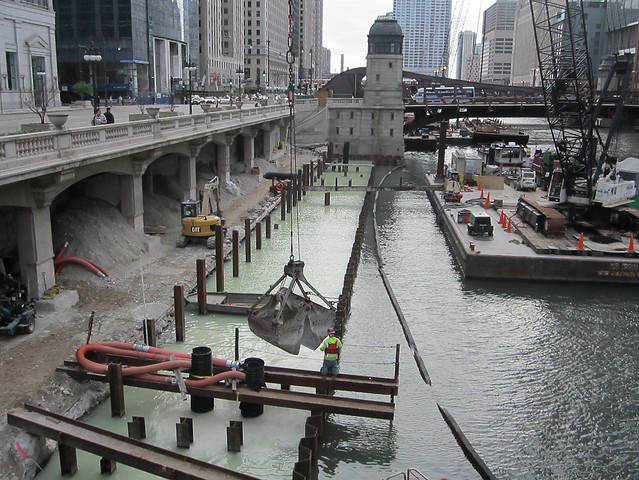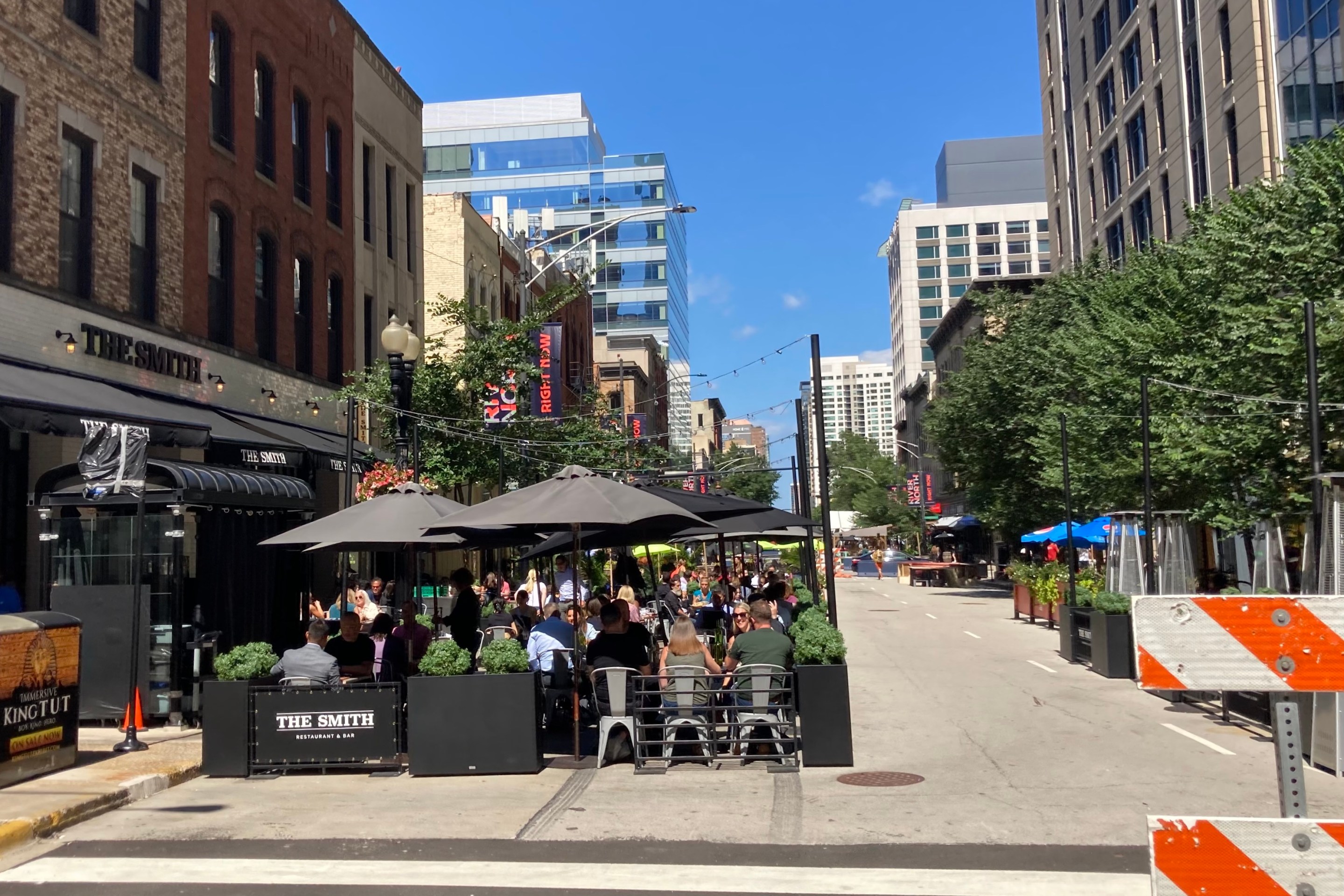Catching Up With Former CDOT Chief Gabe Klein
5:23 PM CDT on June 3, 2014

Since former Chicago Department of Transportation commissioner Gabe Klein stepped down in November, he has been far from idle. He's been active as a visiting fellow with the Urban Land Institute and a board member with the National Association of City Transportation Officials, and last month he joined the board of OpenPlans, the parent organization of Streetsblog and Streetfilms.
Klein is also serving as an advisor, consultant, and sometimes equity stakeholder to numerous transportation and technology companies and organizations. These include TransitScreen, RideScout, Phone2Action, Transit Labs, and Serco. On top of all that, last month, Klein and his wife, Stephanie Plummer, become the parents of a baby girl, Simone Maisie Klein.
I caught up with Klein yesterday, during a visit to his present home of Washington, D.C., where he led the transportation department before moving to Chicago. He gave his take on recent transportation developments in the Windy City and talked about his many current projects. He showed up for the meeting in an ELF solar-and-pedal-powered trike, manufactured by Organic Transit, another company he’s in talks with.
John Greenfield: Have you been following what’s been going on in Chicago since you left?
Gabe Klein: I try to. At least once a week I try to hop on Streetsblog Chicago and the Sun-Times. And I occasionally catch up with someone like yourself or [SRAM Cycling Fund director] Randy Neufeld, or [former CDOT deputy commissioner] Scott Kubly, or [CDOT project director] Janet Attarian, or [CDOT deputy commissioner] Luann Hamilton.
JG: What do you think about what’s been going on with the projects that you launched? For example, the Chicago Riverwalk extension has started construction. It’s pretty crazy: there are these big barges in the river with huge cranes dumping infill to widen the shoreline.
GK: I’m super-thrilled about that project in particular. When I go out and talk about how government can do more with less, or work more quickly on behalf of its citizens, I always use the riverwalk project as an example, because of the fact that during Rahm Emanuel’s first term, we will will have undertaken the conceptual design, the funding, the engineering, and the construction of the first half of the project. Projects like that on average take about 12-15 years to get together, so I think it’s a national example of how to get things done more quickly.
The Bloomingdale Trail had been talked about since 1998. And before Rahm even hired me, he told me, “This is one we’re going to really get done fast, so I need you to jump on it." There was no funding for it. It was a great partnership too, with the Trust for Public Land, the park district, and the planning department. And we all came together and figured out how to get it done, and it’s under construction, again in his first term. So I’m really proud of those megaprojects, as well as the Wells Street Bridge reconstruction, and the new bridge at 130th and Torrence.
But then also, I’m really hoping that other things stay on track, like bus rapid transit and the protected bike lanes. There are always forces at work against progress and innovation, particularly from people that don’t understand those projects. So I’m just hoping that the projects that haven’t started yet, or haven’t finished yet, continue to stay on track.
JG: Anything you’d like to say about how Rebekah Scheinfeld is doing as commissioner?
GK: I haven’t talked to her in a while, but Rebekah is really smart, super-knowledgeable about transit and transportation, and I think she’s a great person to carry out the mayor’s vision and my vision.

JG: So nowadays you’re basically on a bunch of different boards, correct?
GK: I’m a fellow at the Urban Land Institute. It’s a really top-shelf organization that’s focused on, for the most part, progressive land use policies in urban environments. Not just cities, but also suburban areas, like Chicago’s collar counties. They hadn’t had as much of a focus on transportation the last few years. So they wanted me to come in and sort of shake things up a bit and start talking, particularly to the trustees, but also to the district councils, which is what they call the local ULI councils throughout this country and the world, about what’s coming in terms of transportation policy, because things are changing at an exponential rate. It’s no longer linear change.
So that’s one of my main gigs. I also do various consulting gigs here and there, for small companies as well as major companies, usually in technology and transportation. And I’m also on your board. I’m trying to work with Clarence [Eckerson Jr., director of Streetfilms] on a little film that we want to do over in Sweden. He sent me the proposal to read through, and I’ve been so busy with the baby, I haven’t read it. But I'd like to think it would be a little bit beyond just transportation, and focus a bit more on culture. I think it would be fun to do a movie that was maybe like a typical Streetfilm meets Anthony Bourdain.
Also, NACTO created a new strategic advisory board, because NACTO has really reached another level in terms of its growth -- we’re now taking on cities throughout North America, instead of just the U.S., including Toronto, including Mexico City, so it’s sort of a new era. And NACTO is also, with the incredible work done under [Former NYC DOT chief] Janette Sadik-Khan’s leadership, is now in a position where it’s got very reputable planning and design documents out there on the street. I’m actually working on the ULI adopting NACTO's Urban Street Design Guidelines.
As you know, Malcolm Dougherty at CalTrans endorsed the design guidelines. So it’s just reaching a new point. The NACTO board members are, on a day-to-day basis, running their own agencies. So it's useful to have some outside leadership on the longer-term vision, as well as someone looking at the Designing Cities conference and how to make it as effective as possible. We’re working on having a startup day, where we bring all the new technology startups, particularly the West Coast startups, in, so that all the people like myself and DOTs get exposure to all the latest technologies.
And that brings me to my next thing, which is that I’m getting a little bit back to my roots. I’ve spent five years in government, and I spent 15 years in the private sector, mostly with startups. There are these guys who I’m just starting to work with now at Organic Transit. RideScout, which is a really cool, multimodal transportation app, sort of like the Kayak of local transportation, just launched in Chicago last week, and will be announcing a huge expansion next week. Transit Screen provides real-time information in the public way. These are all things that I’ve been passionate about for years.
I’m very interested in the future of how people are going to be getting around cities and next-generation transportation options, the nexus between land use and transportation, telematics and technology that make it very easy for people to switch between modes or share modes. And so I’m still looking at how to approach this business plan [for his own transportation technology startup], but a lot of the companies I’m working with, their services or products play a role in what I ultimately would like to do. But we’ll see, you know.
JG: We haven’t talked about the business you’re working on yourself. That’s kind of under wraps at the moment?
GK: It’s still being formulated.
In addition to editing Streetsblog Chicago, John writes about transportation and other topics for additional local publications. A Chicagoan since 1989, he enjoys exploring the city on foot, bike, bus, and 'L' train.
Read More:
Stay in touch
Sign up for our free newsletter
More from Streetsblog Chicago
Today’s Headlines for Friday, April 19
Tasty news: Friedman Properties is trying to break the Clark outdoor dining stalemate by applying for street closure permits
Mayor Johnson's administration and Ald. Reilly haven't yet found common ground on bringing back the popular car-free zone. Will this make the difference?
Roger that! Streetsblog SF editor Roger Rudick offers constructive criticism of Chicago’s downtown bike network
"There were blocks that felt very safe and very secure," he said. "But then you're immediately – voom! – disgorged into three lanes of moving traffic with no protection."


